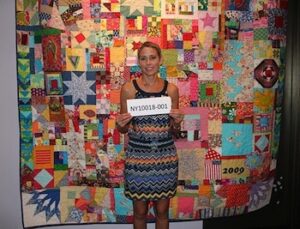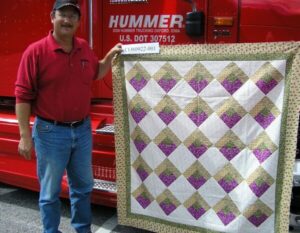Three Interviews That Show Us Why QSOS is So Special
By Emma Parker, Quilt Alliance Project Manager
In our last newsletter, I shared a little bit about the early history of our Quilters’ Save Our Stories (QSOS) project, and our future plans for it, including a forthcoming update to the QSOS guide and a new platform that allows us to pair interview audio with descriptive text. If you missed that “Looking Back” column, you can check it out here.
It’s now been 24 years since the project was founded. Now there are more ways than ever to hear quilters talk about their work, from podcast interviews to magazine features, Instagram accounts, Facebook groups, online classes and guild visits. Quilters are sharing more about themselves and their quilts than ever before. But despite this amazing ocean of information, I still think the QSOS project is a little different. An oral history interview invites a different way of talking about your life and your work than a magazine interview – there’s nothing to sell or promote, so there’s plenty of space to tell your story. And usually, the intimacy of just two people in conversation leads to more in-depth stories from a wide range of quilters.
We’re giving this project a new coat of paint this year in celebration of the QA’s 30th anniversary, so this month, I want to share three QSOS interviews that I think perfectly illustrate why this project is so valuable, for quilters and for anyone who is curious about quilting, making, and a creative life.
 The first reason I think these interviews are so powerful is that they capture a very specific moment in time. Take for example our 2011 interview with quiltmaker Victoria Findlay Wolfe. This was one of Victoria’s very first interviews about her work. In it, she talks about a project called 15 Minutes of Play, which would eventually become the title of her 2012 book. Since this interview, she has published several other books, created multiple fabric lines and quilt templates, won national and international awards for her work, including 2013 Best in Show at QuiltCon, and lectured and taught across the country and online. In her interview, Victoria says that she has only just started teaching, and is beginning to expand her work:
The first reason I think these interviews are so powerful is that they capture a very specific moment in time. Take for example our 2011 interview with quiltmaker Victoria Findlay Wolfe. This was one of Victoria’s very first interviews about her work. In it, she talks about a project called 15 Minutes of Play, which would eventually become the title of her 2012 book. Since this interview, she has published several other books, created multiple fabric lines and quilt templates, won national and international awards for her work, including 2013 Best in Show at QuiltCon, and lectured and taught across the country and online. In her interview, Victoria says that she has only just started teaching, and is beginning to expand her work:
I take it as it comes. I don’t obsess on making a perfect quilt. I’m not sure I can do that, I’m not sure I want to do that. I prefer to learn from each quilt that I do and move onto the next and see what happens. I have felt recently that my work is sort of changing, or perhaps I’m just growing. But I think it’s just being more open to more possibilities and going back and learning and trying other things that I haven’t done before. Building my tool set of quilter skills. I let it happen and see where it will lead me.
 The second reason I love this project is that we hear from all different kinds of quilters, including quilters who make quilts in non-traditional ways or settings. One of my favorite examples of this is Jeanne Wright’s interview with Dave White, a quilter and long-haul trucker. Here’s Dave talking about his mobile sewing studio in the back of his truck cab:
The second reason I love this project is that we hear from all different kinds of quilters, including quilters who make quilts in non-traditional ways or settings. One of my favorite examples of this is Jeanne Wright’s interview with Dave White, a quilter and long-haul trucker. Here’s Dave talking about his mobile sewing studio in the back of his truck cab:
The biggest challenge to doing it and not getting frustrated is organization. I’ve got a–I think it’s a 48 or 42-quart tub with a closing top on it that I keep my notions and my projects in. When I’m going down the road they’ll sit on my bunk. But when I’m quilting or getting prepared to quilt, it goes into one of the overhead areas so that I’ll have enough work space. […] What I found best, is to keep things in Tupperware or plastic containers to a point where I can stay organized and I know where my threads are at and where my needles are and where my machine feet are. Of course the little sewing machine that I’ve got is a Brother sewing machine. It’s a nice little computerized machine. It sits on the floor during transport and it comes up on a platform that I built. It’s basically just a sheet of plywood that I set on one of the cabinets with two little steel legs, I call them pogo legs that I can detach and put in the overhead storage areas. So it’s very confined, but once you get in there and you get involved with the machine and the piecing and the enjoyment, you can lose all track of time.
Even if you’ve never been behind the wheel of a big rig, you might identify with that feeling – of starting to quilt and losing track of time. The QSOS collection contains interviews with quilters around the world, an astronaut who quilted in space, and even a few quilters under the age of 10! But I’d bet that every interview has something that might remind you of your own quiltmaking, or your community.
Finally, the last interview shows how a QSOS interview can help capture a lifelong legacy. In 2008, Karen Musgrave interviewed Donna Sue Groves of Adams County, Ohio. Donna Sue helped create the barn quilt movement starting in 2001, and supported the development of grassroots community quilt trails across the county. She explains the inspiration for the project and the impact it had on her community in her QSOS interview, such as in this excerpt.
Donna Sue Groves passed away in November of 2021, but we are so grateful to have her story documented, in her own words, for her family, her local community, and countless others to enjoy. Recording her story in a QSOS interview helps document the history of the barn quilt movement, as well as Donna Sue’s amazing life.
There are more than 1,200 other interviews that are each as special as these three, and at least that many reasons to support the project. Participate in a QSOS interview, explore our archive of stories, listen and read the interviews, and tune in to Running Stitch, our QSOS podcast. This grassroots project isn’t possible without your support, so consider making a donation to the Quilt Alliance today to help sustain this important collection.
